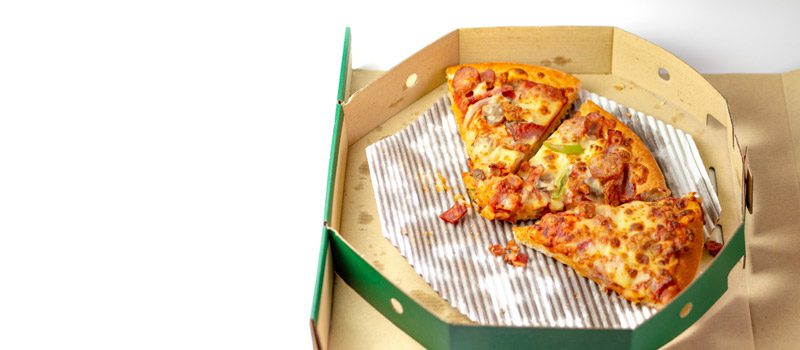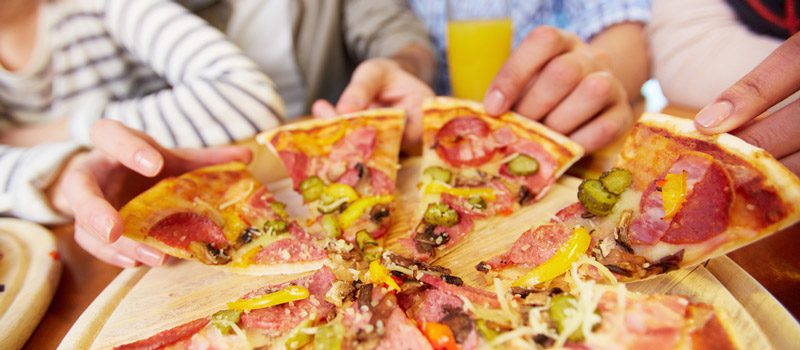No, you can have 3 slices of pizza at once without worrying about your health. It is OK for adults to take 3 slices when ordering a standard-sized pizza, and children can also consume 2 pieces per meal. Generally, consuming two to three slices of pizza with veggies is a safe starting point.

However, as pizza is one of the most adored foods worldwide, it’s not surprising that many people have specific questions regarding eating pizza. If you count yourself among them, here’s some extra stuff to read about pizza intake for you.
How many slices of pizza can you safely consume in one sitting?
Eat no more than three slices of pizza in a sitting to avoid binge eating and maintain your good health. Remember that pizza isn’t usually a well-balanced meal on its own, so get some other vegetables, like a salad, on the side. 2-3 pieces of pizza is an appropriate starting point for the ordinary person.
Even if you order a thin-crust or vegetarian pizza, you may eat a lot more than you need to due to the high levels of saturated fat, sodium, and calories. So, if you want to appreciate your pizza, don’t wolf down the whole pizza instead, have a couple of slices at a sitting.
How many pizza slices can I eat while dieting?

Although the exact number of calories in a pizza slice depends on its size and toppings, one slice of cheese pizza typically contains between 300 and 500 calories. Eating only two pieces of pizza represents more than a third of your daily allotment if you’re on a diet aiming to cut calories to roughly 1,500 per day.
Consequences of eating too much pizza
Eating a healthy diet isn’t about being perfect but rather about making good choices most of the time and rewarding yourself with some of your favorite indulgences on occasion. If pizza is your favorite food, having it once a week is OK. But including pizza as a regular diet can have negative health effects. The following are some potentially harmful effects of eating excessive pizza.
Too much weight gain
Pizza has a high glycemic index, which might make you feel hungry after eating it. It can affect your hunger levels, and you may find yourself eating more. Thus, pizza could lead to excessive weight gain.
In addition, pepperoni and other high-fat toppings increase the calorie count of a single slice of cheese pizza to as much as 400, which can lead to unhealthy weight gain. Having much fat on one’s body can lead to inflammation and several chronic conditions.
Heart disease
The high sodium level and processed meat in certain pizzas are possible causes of cardiovascular illness.
Saturated fat makes up around 20% of the daily recommended intake, yet just one slice of pizza can have that much. Regular consumption of many slices can significantly increase your consumption of saturated fat. In the long run, this might make you more susceptible to serious illnesses.
Risk of developing diabetes
While there is a wide range of pizza options, cheese is always a staple, and high cheese consumption is associated with an increased risk of diabetes.
In terms of carbs, a slice of thin-crust cheese pizza has 80 out of 100, significantly increasing blood sugar. Having a blood sugar spike every once in a while won’t do anything, but having them regularly can increase your chance of getting diabetes, which can lead to serious complications, including neuropathy, blindness, and even kidney failure, as reported by Healthline.
Increase blood pressure
Cleveland Clinic states that eating too much salt will cause hypertension since pizza contains excessive sodium.
According to the American Heart Association, the most extreme form of this illness can lead to an untimely death. If you’re trying to watch your weight, it’s best to skip that extra slice of pizza and fill up on fiber-rich vegetables instead.
Insufficient dietary fiber
Fiber is essential to feeling full and is thus beneficial to your body.
However, unless you also have a large side salad, a couple of pieces of cheese pizza won’t provide you with fiber. The lack of fiber from eating too much pizza regularly can contribute to feelings of constant hunger and even gastrointestinal issues.
Increased risk of stroke
The American Heart Association suggests limiting daily salt intake to 1500 milligrams. With an average of 600–150 mg of sodium per slice, pizza poses a substantial risk for hypertension and stroke due to its high salt content, as reported in research published in “ActaPharmacologicaSinica”.
Worsen your skin
Due to its high glycemic index, pizza can cause a spike in blood sugar, which can cause acne and the production of AGEs. Along with the growth hormones, the cheese’s content is also responsible for skin outbreaks.
What should we do after eating too much pizza?

Few high-calorie meals once a month on occasions, such as pizza, are unlikely to harm health, but frequent pizza binges may cause negative feelings. Are you overindulging in pizza? The following are some activities you can do after eating pizza to start feeling better quickly and maintain your health.
Avoid lying down
It’s normal to feel sleepy and tired after a heavy meal. In contrast, sitting up straight takes less time for your stomach to empty than lying down.
Additionally, because laying down immediately after eating pizza exerts strain on the muscle that typically maintains stomach acid where it belongs, it may cause acid reflux.
Try to walk
Walking is the best exercise for speeding up digestion. When your stomach empties faster, you have less acid reflux and heartburn.
Drink water
Drinking water can help the salt from the pizza to flow out. Remember, to avoid stomach aches, avoid drinking any liquids for at least an hour after eating. After a pizza meal, it’s best to stick to water or other low- or no-calorie drinks for the rest of the day.
The Bottom Line
Everyone like pizza because it’s delicious and satisfying. It’s hard to overlook something like pizza that’s simultaneously hot, sticky, and tasty.
However, pizza consumption should control because of its high-calorie content and other elements that may harm a person’s health. I’ve done my best to explain how to eat pizza and respond to the question, Is 3 slices of pizza too much? I hope this has given you a complete understanding of your subsequent pizza intake.
